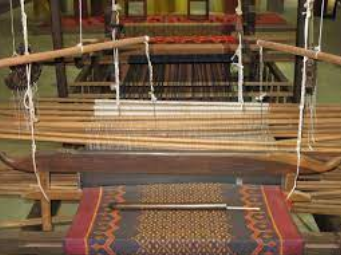
Saris/Unstitched Garments, Textiles, Weaving, Spinning, Khadi
Cotton and Silk Weaving of Uttarakhand
Traditionally, in Uttarakhand, weaving was practiced on pit looms or waist looms. However the width of fabric produced on these were very limited. Mostly tools like drop spindles or foot operated Bageshwari charkhas (spinning wheels) are used. Natural dyeing was practiced traditionally in the region however the colours made were mostly brown and yellows.
In Uttarakhand, the handlooms industry can be divided into three broad categories-Woolen Handloom, Cotton Handloom and Silk Handloom.
Uttarakhand is in the north temperate region and has the advantage of producing apparel grade wool, the finest of all wool grades. The main varieties of apparel grade wool manufactured in Uttarakhand are Harsil, Belchi and Merino. Spinning and weaving of natural fibres like wool and pashmina is traditional to this region. A large section of population is involved in sheep rearing and production of wool especially in the border areas of the state.
The Uttarakhand Sheep and Wool Department Board have taken up the responsibility of overseeing and managing the variety of activities pertaining to the woolen industry. They provide a wide array of services to the sheep farmers for the growth of the industry.
Also the Khadi and Village Industries Board have set up wool banks to provide a number of wool varieties needed to manufacture an assortment of products. Hand spinning is also aggressively promoted by KVIB and it encourages individuals to set up charkhas in homes. Therefore buyers can get authentic handmade woolen products in Uttarakhand.
Traditional weavers producing cotton handlooms are to be found in many villages and localities in District Udhamsinghnagar, Haridwar and Dehradun. Some significant clusters are Kashipur, Jaspur, Mahuadabra (US Nagar), Rampur, Kalsi (Dehradun), Imlikhera (Hardwar) Khateema (Champawat). The handloom units produce home furnishings, surgical cloth and dusters etc.
The Deendayal Hathkargha Yojna has helped 6 weavers’ cooperative societies to modernize their units. As a result helping them to become competitive and produce an attractive range of products. Government Design Centre, Kashipur lends a helping hand to the traditional weavers by offering training, latest designs and modern technologies.
Uttarakhand presents appropriate and unique environmental conditions for producing all types of silk from Mulberry silk in Terai and plain areas to Tassar silk in the hilly areas.
The Oak Tussar Silk is unique to Uttarakhand. Ukhimath in Chamoli district is the main cenre for the production of this silk. Oak Tussar Silk is obtained from worms who rather than feeding on the familiar mulberry tree leaves, feed on the leaves of the oak tree.
Natural dyes derived from plant-based extracts, such as kaphal leaves, dried pomegranate skin, kattha, kilmodh bush etc. are used to dye this variety of silk.
Concentrated efforts in product development in silk based items have been very successful and a variety of silk and combination products are now available, like shawls, stoles, sarees, dress material etc.
Gallery
YOUR VIEWS
PRACTITIONERS: INDIA
Access 70,000+ practitioners in 2500+ crafts across India.
BIBLIOGRAPHY
10,000+ listings on arts, crafts, design, heritage, culture etc.
GLOSSARY
Rich and often unfamiliar vocabulary of crafts and textiles.
SHOP at India InCH
Needs to be written.





